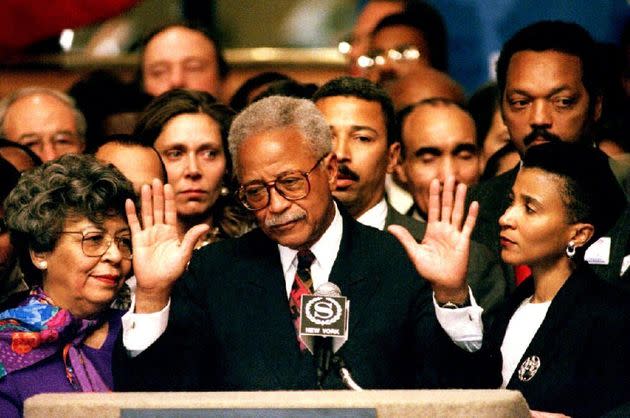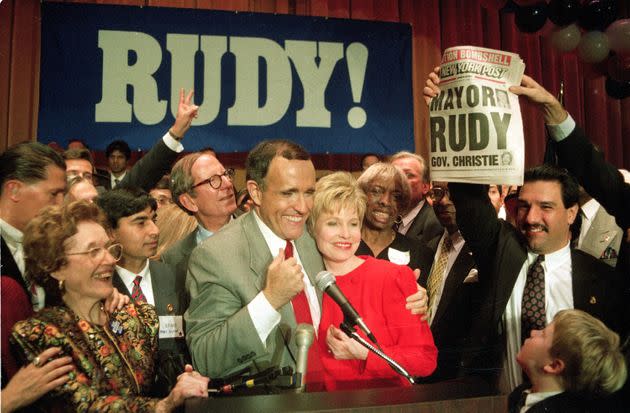Rudy Giuliani Admits To 'Dirty Trick' That 'Kept Down The Hispanic Vote' In NYC Mayor's Race
- Oops!Something went wrong.Please try again later.
- Oops!Something went wrong.Please try again later.
- Oops!Something went wrong.Please try again later.
- Oops!Something went wrong.Please try again later.
During a podcast with former Donald Trump adviser Steve Bannon and failed Arizona gubernatorial candidate Kari Lake, former Trump lawyer Rudy Giuliani admitted to using a “dirty trick” that “kept down the Hispanic vote” in New York City during his 1993 mayoral campaign.
Bannon and Lake laughed along awkwardly as Giuliani described the tactic, which he said spurred a Justice Department investigation and would likely be subject to prosecution today.
The discussion occurred on Giuliani’s “America’s Mayor Live” program on Tuesday night. (Video below.)
After complaining, as he has for years, that he’d been “cheated” when he lost New York City’s 1989 mayoral race, Giuliani recalled spending $2 million on a “Voter Integrity Committee” for his next campaign in 1993. He ultimately beat then-incumbent Mayor David Dinkins by around 53,000 votes.
When Giuliani first raised the scheme, Bannon sarcastically replied, “A dirty trick in New York City? I’m so shocked.”
Giuliani enthusiastically cut him off. “No, played by Republicans!” he said before explaining more.
“Republicans don’t do dirty tricks,” Bannon protested before Giuliani continued, “Well, how about this one?”
“So they went through East Harlem, which is all Hispanic, and they gave out little cards, and the card said, ‘If you come to vote, make sure you have your green card because INS are picking up illegals.’ So they spread it all over the Hispanic...” Giuliani trailed off after Lake exclaimed, “Oh my gosh.”
INS, or the U.S. Immigration and Naturalization Service, was the immigration enforcement agency precursor to various agencies now housed within the Department of Homeland Security.
Giuliani then described how he’d heard from his attorney that the Justice Department, then run by Attorney General Janet Reno, was investigating the scheme for potential civil rights violations.
Giuliani said he told his lawyer, Dennison Young, not to worry because “What civil rights do we violate? They don’t have civil rights! All we did is prevent people who can’t vote from voting. Maybe we tricked them, but tricking is not a crime.”
Nowadays, the former Trump lawyer and New York City mayor acknowledged, he might face prosecution for the suppression tactic. “And that’s the way we kept down the Hispanic vote,” he concluded.
At that point, Lake butted in to clarify: “Not the legal vote, the illegal vote.”
“Of course!” Giuliani replied. “The Hispanic illegal vote, which takes away the Hispanic legal vote.”
Giuliani said Randy Levine, now president of the Yankees, and John Sweeney, a former U.S. congressman, led his “Voter Integrity Committee.”
Sweeney told HuffPost Giuliani’s claims were “nonsense” and said he and Levine ran a “legitimate” operation.
Levine, in a phone call Thursday, acknowledged that he and Sweeney ran Giuliani’s voter integrity team, describing it as focused on “getting poll watchers and attorneys when there was a dispute.”
However, he said, he had “no knowledge” of the scheme Giuliani described on the podcast and that the voter integrity unit had nothing to do with it.
“My only knowledge was what was in the news back then and shortly after 1993,” Levine said. “I was never contacted by the Justice Department on this investigation because it was clear it did not come out of our operation.”
News reports and a government press release from the time roughly line up with Giuliani’s claims.
The New York Times, announcing Giuliani’s election win, noted that Dinkins had called a noon news conference on Election Day to accuse his opponent of “voter intimidation and dirty tricks,” including the charge that pro-Dinkins posters in English and Spanish were put up in Washington Heights and the Bronx. According to the article, the posters “suggested that illegal immigrants would be arrested at the polls and deported if they tried to vote.”
Giuliani said at the time the allegation had “nothing to do with my campaign,” the Times reported.

New York City Mayor David Dinkins gives his concession speech on Nov. 3, 1993, after narrowly losing to Rudy Giuliani.
A press release from that Election Day from James P. Turner, then the acting assistant attorney general for civil rights in the Clinton administration Justice Department, said the department was aware of “posters … placed throughout New York City misinforming voters about the role of Federal officials in today’s elections.”
The release encouraged voters to ignore the posters and stressed that no immigration officials were at polling places and that federal observers “are not there to enforce immigration laws,” but rather, to protect the rights of minority voters. The release also stated that the department would be investigating the posters and “allegations that individuals are intimidating and harassing voters at polling places.”
A few days after Election Day, The Washington Post reported that the Justice Department was probing complaints about efforts to suppress the vote in Democratic-leaning minority neighborhoods in New York City.
The report (authored by Thomas Edsall and Malcolm Gladwell), described various complaints about election incidents — including signs warning that “federal authorities and immigration officials will be at all election sites … Immigration officials will be at locations to arrest and deport undocumented illegal voters.”
Then-Mayor Dinkins’ campaign recorded the license plate of a car carrying men that allegedly put up the signs, and police traced it to the wife of a policeman living in Rockland County, New York, according to the report. A separate incident reportedly involved multiple men disrupting a polling place in Bedford-Stuyvesant, a Black and Latino neighborhood in Brooklyn.
Another incident reported by The Washington Post matches Giuliani’s claim even more closely. The article states: “In East Harlem, Debra Wilson, a voter, said Giuliani workers sought to intimidate prospective voters by asking for their green immigration cards.”

Giuliani celebrates as a supporter holds a newspaper with a headline declaring him the city's new mayor on Nov. 3, 1993.
Writing in the socialist journal Against The Current shortly after the election, activist Andy Pollack noted, “Cops put up phony Dinkins posters in mostly Dominican Washington Heights, saying the INS would be checking voters’ documents at the polls. In some cases police themselves asked Latino voters for their passports.”
Finally, the journalist Wayne Barrett reported multiple times on the Giuliani campaign’s tactics. In 1998, five years after the election, Barrett wrote that Giuliani’s Election Day operation flooded polling places “with lawyers and off-duty cops and firemen to try to prevent a repeat of 1989.”
Three years later, Barrett noted of the 1993 race, “Giuliani’s election-day operation featured thousands of white off-duty cops, firemen, and corrections officers, assigned to ‘monitor’ black districts by Giuliani, which Dinkins denounced as ‘an outrageous campaign of voter intimidation and dirty tricks.’ The hubbub over these ads and tactics was forgotten overnight.”
It’s true that noncitizen migrants can’t vote in New York City elections — despite a change to the law passed by the city council in 2021, which was struck down by a Staten Island judge.
But voting rights activists have long said that voter suppression efforts aimed at that community, such as proof-of-citizenship requirements, can also suppress the votes of legal U.S. citizens of Latino descent.
In 1982, the Justice Department reached a consent decree with the Republican Party after a series of voter suppression efforts in New Jersey in the early ’80s, including off-duty law enforcement officers stationed at polling places in Black and Latino neighborhoods with “National Ballot Security Task Force” armbands.
The consent decree was lifted in 2018.
